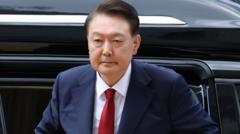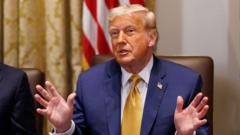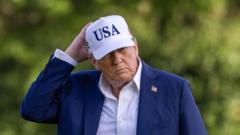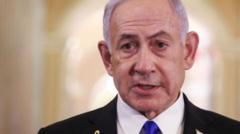In a bold move, President Trump has announced substantial tariffs aimed at Japan and South Korea, igniting tensions between the United States and these significant trading partners.
Trump Imposes New Tariffs on Key Asian Trade Partners

Trump Imposes New Tariffs on Key Asian Trade Partners
President Trump's latest tariff measures raise concerns over future trade relations.
On July 7, 2025, President Trump declared a new 25% tariff on exports from Japan and South Korea that will take effect on August 1. In a related move, he announced the extension of a pause on broader tariffs, which were originally set to escalate tomorrow, allowing for continued negotiations with other nations. The decision caused a stir in the markets, with investors reacting negatively to the steep tariff increases targeting two of America's most crucial trade allies.
In addition to tariffs on Japan and South Korea, Trump outlined a range of increased tariffs on several other countries, including 40% on Myanmar and Laos, 30% on South Africa, and 25% on Kazakhstan and Malaysia. Detailed letters from Trump regarding these tariff decisions were shared on various social media platforms, raising alarm over the potential repercussions for global trade dynamics.
For the past three months, the U.S. administration has been engaged in trade discussions with multiple countries; however, preliminary agreements have only been reached with Britain and Vietnam. Negotiations with Japan and South Korea have been notably sluggish, hampered by recent elections in both countries and apprehension regarding further protective tariffs on their main exports such as automobiles and technology.
Both Japan and South Korea have expressed reluctance to finalize trade agreements, fearing future tariff threats may render potential deals unfavorable. The unfolding situation reflects a significant pivot in U.S. trade policy, amidst growing international tensions over economic strategies.
In addition to tariffs on Japan and South Korea, Trump outlined a range of increased tariffs on several other countries, including 40% on Myanmar and Laos, 30% on South Africa, and 25% on Kazakhstan and Malaysia. Detailed letters from Trump regarding these tariff decisions were shared on various social media platforms, raising alarm over the potential repercussions for global trade dynamics.
For the past three months, the U.S. administration has been engaged in trade discussions with multiple countries; however, preliminary agreements have only been reached with Britain and Vietnam. Negotiations with Japan and South Korea have been notably sluggish, hampered by recent elections in both countries and apprehension regarding further protective tariffs on their main exports such as automobiles and technology.
Both Japan and South Korea have expressed reluctance to finalize trade agreements, fearing future tariff threats may render potential deals unfavorable. The unfolding situation reflects a significant pivot in U.S. trade policy, amidst growing international tensions over economic strategies.





















